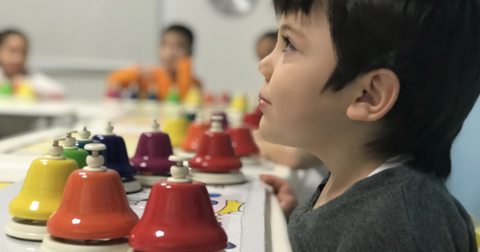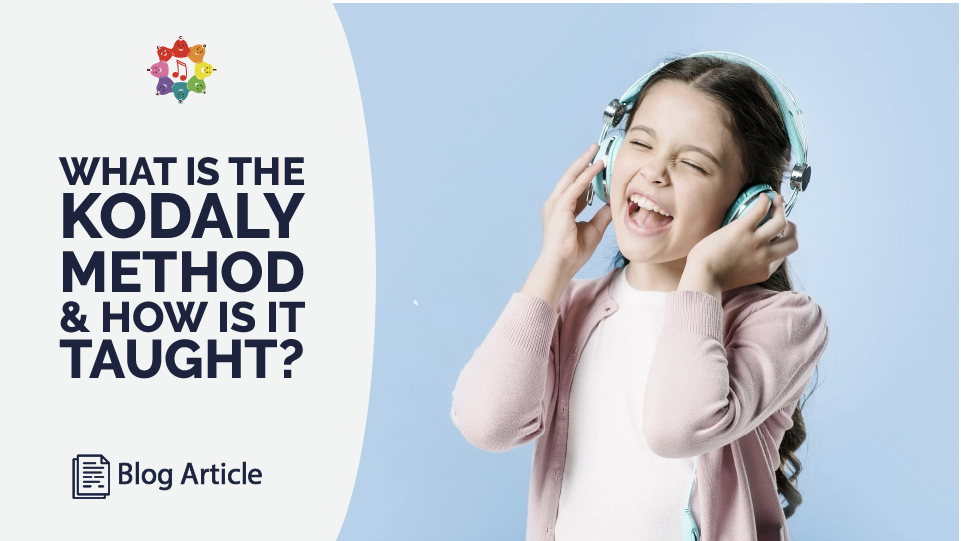A Hungarian composer and educator named Zoltan Kodaly created an ingenious teaching method nearly 100 years ago. His approach emphasized collaboration, expressiveness, creativity and other skills. It put instrument skills and theory on the back burner, so to speak. Kodaly’s method flourished and is today one of the preferred ways to expose young children to musical concepts.
What is the Kodaly Method?
In a class that incorporates Kodaly methods, youngsters learn to use their own voices as the primary instrument. They learn the “do-re-mi” system but with a unique twist: the “do” is moveable based on their own vocal abilities.
Here at Prodigies, we tend to use fixed do in an effort to emphasize the young child’s ability to develop their sense for absolute pitch, but Kodaly is famous for it’s emphasis on moveable Do, where the tonic (scale degree 1 is always Do).
That said, we have added a many new movable do songs to our catalog in the last few years, because we know how important it is to music teachers.  )
)
They also learn natural rhythm, what the teaching calls “organic collaboration” with other learners in the class, and multiple forms of spontaneous creativity as a way of expressing themselves musically.
The Basic Kodaly Principles

What are the essential components of this highly effective system for teaching music? There are many key features to the Kodaly method that can be boiled down into five main concepts:
- The importance of music education: Kodaly himself was a firm believer in the value of early childhood music education. His entire method is based upon the concept that very young children are the most adept learners of musical principles. In fact, he once joked to an interviewer that the best time to begin a child’s musical education is “nine months before birth.”
- Teaching in a logical way: Even though the system encourages freedom of expression and improvisation in many ways, the curriculum is carefully structured to teach in a logical sequence, each new lesson building upon the last one.
- Making it fun to learn music: The Kodaly philosophy also emphasizes the concept of joy and fun. There’s an upbeat, happy atmosphere in classes no matter how old the learners are. Kids look forward to learning about music when they are able to approach the subject from a positive angle.
- Using the voice as the central instrument: Long before Kodaly students pick up an instrument, they learn to use their voices to find notes and melodies. Not only do they learn to hear and transcribe music, they learn to sing musical notes they see on paper. But in the early stages of the method, it’s all about using the voice as the central instrument for creating musical sounds.
- Teaching through folk songs: Kodaly was Hungarian but was a dedicated proponent of teaching children via their own culture’s folk songs. He often pointed out that folk songs are ideal “basic” musical pieces that incorporate many key ideas and forms that help children learn to listen, remember and create their own music.
Advantages of Using the Kodaly Approach
Perhaps the primary advantage of the Kodaly method is its reliance on all the human senses.
Kindergarten groups, for example, teach kids to feel the musical pulse, hear the pitch and sing along. By joining in, as a group, the little learners notice that different people make different sounds, and that pulse is actually a physical aspect of songs.
They play drums and other simple instruments as they learn nursery tunes, folk songs and other child-appropriate melodies.

What do the youngsters learn while they’re having all this fun?
Among other things, they instinctively pick up musical dynamics, style, pitch, mood, tempo, rhythm and form. These classes are proof positive that musical education can be immensely fun and intensively advantageous for kids of all ages.
Later on, after the basic classes, children are exposed to hand signs, the various names of rhythms, the do-re-mi system and more advanced musical concepts. There’s never any forcing or coaxing because the students naturally want to learn. After all, what young child doesn’t enjoy a sing along with drum playing?
Another basic concept of Kodaly education is collaboration. There is a uniquely social aspect to every class because students are always learning together. The social, inherently human side of music is at the core of Kodaly. A typical class, for example, might incorporate singing in rounds, duet performances or the entire small group of pupils singing together, like a choir.
There’s never a dull moment in a Kodaly class, which is one reason kids always look forward to attending and participating. All the kids are encouraged to join in the many activities that take place, and no two classes are exactly alike. Kodaly built the curriculum around the idea that concepts need to be introduced in a particular order. That way, no one is ever left out. Additionally, the progression from one musical lesson to the next is never rushed but always deliberate and based on how well the students are assimilating the material.
Kodaly For All Ages
Kodaly is not about “perfect pitch” or other traditional music concepts. Instead, learners of all ages are exposed to the idea and practice of relative pitch, improvisation and rhythm. The beauty of Kodaly is that it can be adapted for people of any age and any level of musical ability.
Indeed, many adult musicians delve into the system and discover many benefits. At the same time, adults who know absolutely nothing about music can learn first-hand the power of the Kodaly method and often move through the curriculum quite quickly.

A Lifetime of Kodaly Education
The benefits of early childhood music education are numerous. By combining the Kodaly method with our other approaches for teaching children, our team at Prodigies Music is able to offer a well-rounded curriculum to kids of all ages. Who can benefit from this ingenious type of instruction? Here’s a short list:
- Children: The younger they’re exposed to Kodaly, and music in general, the better. It’s common for pre-school students to join Kodaly classes. Kids as young as two can benefit from this unique way of learning about music.
- Adults: Kodaly was designed for learners of all ages, and many adults discover the beauty and wonder of music from early adulthood through old age. Some adults choose to approach the curriculum on their own after reading a few books on the subject. This a a good way to begin but eventually it’s best to join a class. A central concept of Kodaly learning is that it’s a group effort.
- Musicians: Professional and amateur musicians often point out that early childhood musical education, particularly Kodaly-based methods, helped them throughout their careers and made them into better musicians.
- Artists: Painters, sculptors and craftspeople of various disciplines have used to the Kodaly learning system to enhance their diverse knowledge bases and sharpen their skills. A basic understanding of music seems to open the mind in profound, subtle ways.
- Teachers: Instructors who incorporate Kodaly principles into their overall curriculum often find that the basic philosophy behind the method is an educationally sound conceptual framework that helps them become better teachers.
At Prodigies Music (www.prodigies.com), our professional instructors are experienced with teaching the Kodaly method to learners of all ages, whether for singing or instrumental classes. It’s truly amazing how the system helps youngsters flourish at such a young age. As Kodaly himself suggested, it’s best to begin music education as early as possible because children are able to assimilate so much of what they hear, see and experience.


